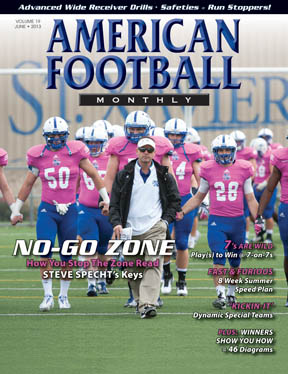Article CategoriesAFM Magazine
|
Safety First – Beat the Heat© More from this issueAugust camps are coming soon and that means the hottest weather of the year. It is important for coaches – at all levels – to ensure their players are properly hydrated at all times. Perhaps the best advice for football coaches at the beginning of August practices is to take it slow and allow players to gradually get acclimated to the heat. “Heat acclimatization is the number one controlling factor that can help prevent heat illness,” said Brendan McDermott, an associate professor in kinesiology at the University of Arkansas. “Gradually introducing equipment and heat exposure over a 10-day period is the best way to facilitate heat acclimatization in football players.” Rest breaks during practices are also critical. “Providing rest breaks and allowing adequate recovery time between practices is advantageous to players in helping prevent heat illness and getting the most out of them during activity,” added McDermott. “Removing helmets and pads during conditioning-specific practices allows greater heat dissipation and can help prevent illness as well.” Lew Johnston, the head coach at Nansemond-Suffolk Academy (VA), suffered from dehydration while playing college football in the mid 1960’s. “Coaches looked at having water at practice as unmanly or being a sissy then,” said Johnston. “It was either that belief or that if you drank too much water, you would get waterlogged or bloated.” Johnston collapsed one August day during a practice. “I fell over and was out for about 20 minutes. The next thing I knew I was covered in ice to cool down my body temperature,” he said. “The trainer was there and stayed with me as my body temperature came down gradually.” Johnston has also visited August practices at Virginia Tech. “We’ve had a few of our players play at Virginia Tech and having been there at a practice, they have student assistants walk around the entire time with squirt bottles and water drinks,” he said. “That may be difficult to do on the high school level but there needs to be access to water at all times.” According to David Buchanan, the head coach at Mason County High School (KY), “It’s important that players understand they should be hydrated properly before practice. if they’re not, we’re all looking for trouble,” Buchanan said. Buchanan’s players bring water and water drinks in thermoses which are with them all the time. “Our regular practice routine includes a practice burst, rest, and recovery. Having water at regular intervals is part of that routine.” Understanding that being properly hydrated 24/7 is also important. “As coaches, one of the most important things we can do is to make sure the parents and the players know that proper hydration starts at home,” said James Housdan, the head coach at Parker Chapel High School (AR). “At our practices, the coaches and players have an understanding that the kids can get water whenever they feel they need it. We want to err on the side of caution.” To guard against heat illnesses, the National Athletic Trainers’ Association and the Korey Springer Institute have combined to list a number of tips. KSI was named after the Minnesota Vikings offensive tackle who died from complications from heat stroke in 2001. |
|
| HOME |
MAGAZINE |
SUBSCRIBE | ONLINE COLUMNISTS | COACHING VIDEOS |
Copyright 2025, AmericanFootballMonthly.com
All Rights Reserved




